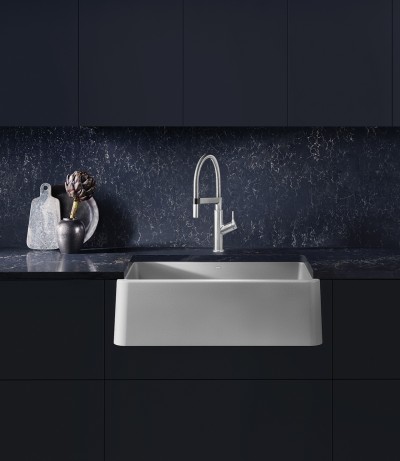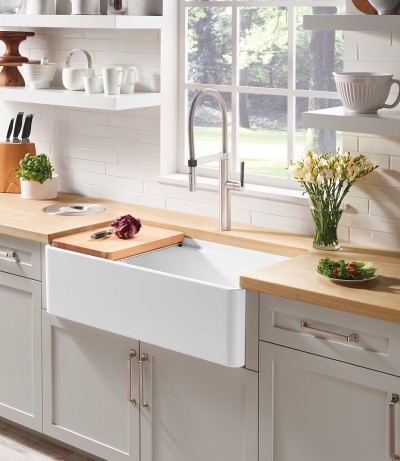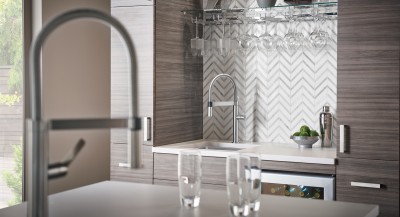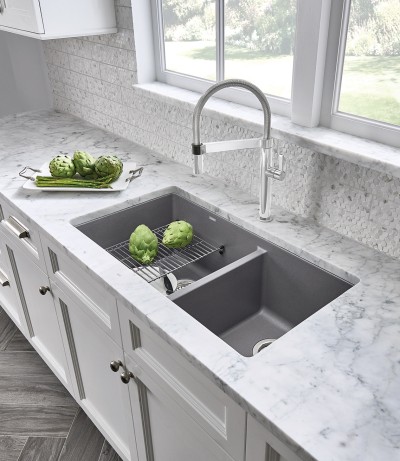Consultez la page OÙ ACHETER pour trouver le revendeur le plus près de chez vous. N’hésitez pas à les appeler ou à visiter leur site web pour vérifier que les produits qui vous intéressent sont en stock.
Foire aux questions sur les produits BLANCO
Où puis-je acheter les produits BLANCO?
Puis-je acheter des produits directement auprès de BLANCO?
Nous ne faisons pas de vente directe, nous exploitons seulement un centre de distribution. Trouvez le revendeur le plus près de vous en visitant la section OÙ ACHETER du site web.
Comment puis-je enregistrer ma garantie auprès de BLANCO Canada inc.?
Vous devez conserver votre reçu de caisse daté comme preuve d’achat pour vous prévaloir de la garantie. Pour plus de détails sur la garantie, visitez notre page de garantie.
Pourquoi la plupart des drains d’éviers BLANCO sont-ils déportés vers l’arrière?
Le déport du drain d’évier maximise le volume utile de l’évier. Cela libère aussi de l’espace de rangement dans l’armoire sous l’évier, le tuyau d’écoulement étant positionné au fond de l’armoire, plus près du mur.
Quelle est la différence entre un évier à montage sous plan et un évier à montage en surface?
Un évier à montage sous plan est accroché sous le comptoir. C’est la méthode d’installation la plus connue et la plus utilisée pour les comptoirs en pierre. Il n’est pas possible d’installer un évier à montage sous plan sous un comptoir en stratifié.
Un évier à montage en surface repose directement sur le comptoir. Ces éviers sont dotés d’un rebord qui repose directement sur le comptoir et qui supporte l’évier. Ils sont compatibles avec les comptoirs en pierre et en stratifié. À noter: la plupart de nos éviers à montage en surface peuvent aussi être installés sous plan.
Reportez-vous au gabarit inclus dans l’emballage de votre évier pour plus de détails. L’installateur du comptoir utilise le gabarit pour découper l’ouverture de l’évier.
Trois considérations importantes avant d’acheter un évier
- La profondeur du comptoir et la largeur de l’armoire
- Les fonctionnalités qui vous intéressent
- Le type de matériau
Visitez notre GUIDE DE SÉLECTION D’ÉVIER pour en savoir plus sur ces étapes essentielles!
Comment installer un évier avec égouttoir?
Les éviers à égouttoir sont installés de la même manière que les autres modèles d’évier de cuisine. Un évier à égouttoir nécessite une découpe complète du comptoir, afin que l’on puisse y insérer l’égouttoir. La section égouttoir de l’évier n’est pas déposée sur le comptoir, mais bien insérée à travers le comptoir. Un évier à égouttoir est très pratique et prolonge votre espace de travail. L’égouttoir peut généralement être installé du côté gauche ou du côté droit de l’évier, à votre choix, selon l’aménagement de votre cuisine.
Vous retrouverez dans l’emballage un gabarit et des instructions d’installation détaillées.
Comment puis-je devenir un revendeur de produits BLANCO?
Veuillez nous écrire à info@blancocanada.com
ou nous appeler sans frais au: 1-877-425-2626




